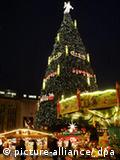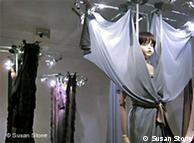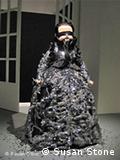紐約市的光線是不太一樣的
曾令Matisse驚豔
Art
Full Constant Light

Librado Romero/The New York Times
The Rose Window at the Cathedral of St. John the Divine. More Photos >
Published: December 25, 2008
At this dark time of the year, we like light. So we have festivals of light: Hanukkah, Kwanzaa, Christmas, and New Year’s Eve too, with its bright parties, and fireworks, and the fabulous walk-in lantern that is Times Square.
Times Square, of course, is a lantern year round. In cities the lights are always on. To a large degree cities are constructed of light enclosed and released. This is what attracts people to them, the great blaze that never goes out. And the light is extremely varied. From our Bronx apartment, we look one way and see sunlight changing color on nearby high rises and a Milky Way of all-night Manhattan lights beyond. The view in the other direction is to empty sky and the Hudson, by day as mutable in tone as gray jade and all but invisible after dark unless a passing ship tells you it’s there. Same city, different impressions of light.
But this is true in any neighborhood, anywhere, just as it is true of images of light in art spread across the city. And the way light looks depends a lot on who’s looking. In the 19th century American landscape artists hiked the wilderness, taking field notes on natural light, obsessively recording its qualities at specific times and places. When they returned to their city studios to paint, though, they bathed their landscapes in a theatrical glow that showed little evidence of direct observation.
For them light was a complex element; a hard, recordable fact, yes, but also a symbol, a big idea. In a new nation still deeply religious and in search of a triumphal identity, light in art implied revelation. And what was being revealed was God’s plan for America as the chosen land, the New Eden. Divine light shone on it and on the artists inventing its national image.
Time passed. Culture changed. And light, ever volatile, has taken on many other roles in art. Sometimes it is used to obscure rather than clarify meaning. Sometimes it serves as a warning rather than a warming agent. Traditional religious associations hold. Light streaming from the great Rose Window at the Cathedral Church of St. John the Divine seems austerely empyreal in the recently scrubbed and brightened interior.
But increasingly, illumination has become a private experience, the way poetry is: one piece matched to one reader, a reader willing to be “lit with piercing glances into the life of things,” to quote Marianne Moore. Moore, a lifelong New York City resident, did not take aesthetic revelation casually, but she was pragmatic. She understood you had to seek it to find it. She found a constant source in her hometown.
Poetic and pragmatic is an apt description of New York and its light. This is an island city — of its five boroughs only the Bronx is part of the North American mainland — with an island light, alternately obdurate and romantically moody. It can be too candid. Noon light in New York is not going to make you look rosy if you’re pale, or rested if you’re tired, or younger than you are. But its toughness is democratic: it falls on everybody and everything the same way.
You can see this in a set of photographs by Rudy Burckhardt (1914-1999) at the Metropolitan Museum of Art. Born in Switzerland, Burckhardt came to Manhattan in 1935 when the city was still in the grip of the Depression. Fascinated by the city but shy about using a camera on the street, he first shot architectural details, then the feet of pedestrians and finally the walkers themselves, most of whom didn’t notice him.
That warming up is documented in the slender album Burckhardt put together and hand-titled “New York, N. Why?” Its original pages, with pasted-in pictures and six sonnets by his partner at the time, the poet and dance critic Edwin Denby, make up the Met show.
With its images of newsstands, advertising and sidewalk traffic, the album is an essay in period culture. And with its shots of architecture it becomes a study in light used by the artist as a ready-made construction material, as solid as steel and stone, as abstract as the bars and blocks of Mondrian. In front of the light structures New Yorkers boogie and strut in place, nailed down by their cast-iron shadows. Denby’s poems echo the pictures’ mock-monumentalism:
When they build for a million a day to use it,
What is the point in, say, five hundred years,
Abroad they’ve still got the pyramid of Whoosis,
Would it last in New York? The answer is, who cares.
In 1939, while Burckhardt and Denby were compiling the album, they met Fairfield Porter, a figurative painter and near-contemporary who would later become a probing art critic. Most of his paintings were portraits of friends and family set in domestic interiors, with the figures and space alike defined by modulations of light and shading.
Someone once asked Porter what he looked for when he visited museums. “Light,” he said. He found it in the art of Édouard Vuillard and in the paintings of Edward Hopper, a big influence. Hopper’s light tends toward the stagey, but in a painting like “Queensborough Bridge,” at the Whitney Museum, it doesn’t go there. It doesn’t hint at teasing, B-movie back story. It’s realism plain style: an image of a particular structure in the particular light of a damp gray day.
When the poet John Ashbery described Porter’s colors as “transparent and porous, letting the dark light of space show through,” he might have been speaking of Hopper too, or of this Hopper at any rate. Like Porter’s art, Hopper’s exemplifies one version of American-style luminosity, painting that has some sort of spiritual dimension, but is also as unpretentiously humane as a piece of fine, body-friendly furniture.
I’d say the same of certain abstract art too, including the early woven work of Lenore Tawney. Tawney, who died last year at 100, developed a distinctive, unfancy, off-the-loom tapestry technique that left areas of otherwise dense weave translucent. An example from the 1950s, “Jupiter,” is now on view at the Museum of Arts and Design, though disadvantageously displayed, flat against a wall.
Were it freely suspended, preferably near a window, light would filter through the fabric. Such a presentation would allow the central, circular planetary emblem to optically shimmer and spin and would clarify the equal importance of two sources for Tawney’s art: Bauhaus practice and Asian mysticism. “A shine is that which when covered changes permission,” wrote Gertrude Stein. “Jupiter” should be given permission to shine.
The quality of transparency — letting light through — sounds straightforward enough but isn’t. When Ralph Waldo Emerson referred to himself as a “transparent eyeball,” he was talking about extreme experiences of cosmic consciousness, and ego loss as destabilizing as it was ecstatic. The poet Anne Porter, the wife of Fairfield, spoke of transparency as desirable but paradoxical, describing poetry and art that “lucidly shows you something that is a mystery.”
For the contemporary artist Daniel Joseph Martinez transparency as fulll disclosure is suspect and potentially subversive. His new sculpture “the west bank is missing, i am not dead, am i,” installed in the City University of New York Graduate Center, has, it seems, nothing to hide. In the form of two enormous upright rings, it is made of clear plastic, looks abstract and is fully visible from the street.
The piece is, however, coded. Odd-shaped patterns stamped into the plastic were molded from two architectural models. One was for a suburban development in Irvine, Calif.; the other, inspired by that plan, for an Israeli settlement project on the West Bank. In the United States modern suburban communities have often served to isolate middle-class whites from urban minorities. In Israel, Mr. Martinez suggests, another kind of apartheid is in operation.
None of this is immediately evident from the glowing, helix-shaped sculpture. But once understood, its lucidity clouds over. In this case, as so often in politics, transparency means hiding truth in plain sight.
Mr. Martinez is not a romantic when it comes to using light as a symbol; other politically minded artists are. In 1950 the California artist Chesney Bonestell (1888-1986) produced a fantastically melodramatic oil sketch of an apocalyptic scene: New York City ruined and in flames after an atom bomb attack.
The picture, at the New-York Historical Society, was commissioned as a magazine illustration at the height of cold war paranoia. Now, inevitably, it brings 9/11 to mind. But it also carries art historical resonances: the reds and oranges of Bonestell’s conflagration are the same used in 19th-century American paintings of sunsets, intended as emblems of a nation under providential care.
Just such a sunset is essential to a Robert Gober installation called “Prison Window” at the Andrea Rosen Gallery in Chelsea, though here the effect is distanced, if not sardonic. There isn’t much to the installation, which is basically a piece of stage design consisting of a small barred window set in the gallery wall with a sunset painted on a second wall behind it.
We all know such light and have feelings about it, possibly strong ones: sunset sadness is built into our culture; late-day light is associated with partings, endings, the coming of night, not to mention Hollywood westerns. Is Mr. Gober suggesting we are prisoners of such feelings, locked in by nostalgia — that passive and unprogressive emotion — and by art that promotes it?
Whatever his meaning, there’s no question that light is a trigger of memory. And much art, like much poetry, is focused on the past, examining it, revising it or simply evoking it as George Tooker does in his 1952 painting “Garden Party,” included in his retrospective at the National Academy Museum.
Mr. Tooker’s formally exacting work has taken several directions in the past half-century, alternating political subjects with portraiture and religious painting. In “Garden Party” he is dealing in personal memory, specifically the recollections of summers when he was a child and even more specifically what light was like then: the early evening sky with the moon and one star; the soft flush of Japanese lanterns in the garden. Although the painted scene is highly stylized, the light rings true. It feels like the real, lived-in but long-lost thing, the way it does in the paintings of Aelbert Cuyp and Edward Hicks and Watteau.
Past is past, and if one
remembers what one meant
to do and never did, is
not to have thought to do
enough? Like that gather-
ing of one of each I
planned to gather one
of each kind of clover,
daisy, paintbrush that
grew in that field
the cabin stood in and
study them one afternoon
before they wilted. Past
is past. I salute
that various field.
The poem, about the past remembered and embraced, is by the New York writer James Schuyler (1923-1991), about whose work Fairfield Porter wrote it “tends toward a deceptively simple Chinese visibility, like transparent windows on a complex view.”
What is most complex about the view — any view — is the reality of change, every minute, all the time, “like in water a reflection” as Denby puts it in the palooka patois of his sonnets. The light on the buildings outside the windows changes, the all-night lights of the city, the shadow of clouds on the river, the light through a rose window, the light through a sculpture, the light in Times Square, where one year will soon be seen out, while another, with a sizzle of light, brought in. Change, like light, can be blinding; it can also show the next right way to go. All we can do about the confusion is what artists do: keep looking and thinking, and making the mind and eye — Denby once more — the shutter of a camera that is open forever.

















